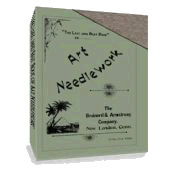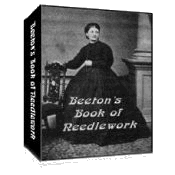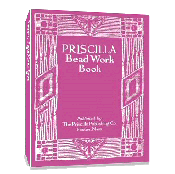Towelling Embroidery
Towelling Embroidery was very popular in the 1880’s. It was so named from the foundation being of a thick material that was suitable for towels. Java Canvas, Honeycomb, and white or stone colored linens were generally used.
Towelling Embroidery consists of making borders of Drawn Work and embroidering stars on the plain squares left between the drawn threads and the center of the material. The stars are made with Satin Stitch and lines of Herringbone, Chain, or Feather Stitches worked either in filoselle, single Berlin wool, double crewels, or ingrain cottons (or today's equivalents).
This type of embroidery was used for tablecloths, antimacassars, toilet cloths, bed pockets, mats, as well as for the ornamental towels that were hung in front of the everyday towels used in a bedroom.
To achieve the beautiful effects as shown in Fig. 1, a strong and coarse linen material is required. Cut it to the size necessary, adding two inches for the fringe. Measure two inches from the cut edges and make a line of BUTTONHOLE STITCHES spaced wide apart. Leave an inch of material and then draw out threads beyond it to the depth of half an inch, leave a quarter of an inch of material, and draw out another half inch of threads, leave a quarter of an inch of material and draw out another half inch of threads. Draw out the threads in this manner along the four sides of the material. At each corner the only threads left will be those belonging to the undrawn parts of the material.

Great care must be taken in cutting the threads, particularly at the corners, as a wrong cut of the scissors will spoil the whole work. To protect the corners at their edges, work a close and narrow line of Buttonhole stitches with fine cotton. This stitching should be close and narrow enough not show in the design.
Take a bright colored floss or wool, and work a line of CROSS STITCH round the outer edge of the drawn threads. Fill in the spaces left between them with the same lines of Cross Stitches. Take a piece of fine Crochet cotton and make with it the pattern formed of the threads left in the material where the rest have been drawn away. Fasten the Crochet cotton securely at one of the corners, carry it across the first open space, divide in half the few threads between this and the next open space, take the last half upon the needle, and twist them over the first half, draw up the needle and cotton, and repeat to the end of that corner. When the threads are reached that are close together, divide them off into sets of eight threads, and take the last four first upon the needle, and twist them over the first four. Repeat until every space of drawn threads is worked over. Work small WHEELS over the open squares left at the corners. Fill in the center of the design with stars made with colored floss. Finish by drawing out the threads to form a fringe.
Fig. 2 shows the centers of the Towelling Embroidery in a pattern using the Holbein Stitch.

To work this, first trace out the design upon fine linen or count the threads during the progress of the work, if using coarse materials. Work this entirely in HOLBEIN STITCH.
Towelling Embroidery Used For Nightgown Cases
If using Towelling Embroidery for nightgown cases, omit the Drawn thread border and the fringe. Before starting a pattern, work a border with single Cross Stitches close together. The simplest design is to cover the center with six pointed stars, made in a wool of a bright shade, and to connect these together with long lines of SATIN STITCH worked in a darker shade of wool.
As you can see from Figure 1, the end result is truly beautiful. It is easy to understand why this type of embroidery was so popular with the Victorian ladies.
Return to top of Towelling Embroidery page.
Return to Types of Embroidery page.
Return to Home page.link rel="stylesheet" href="/support-files/mystyle2.css" type="text/css">



 433 pages!
433 pages!

